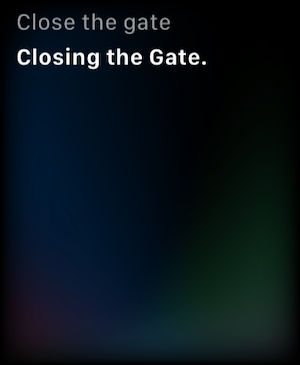Adventures in HomeKit: Part 2
Aside from my venture into home lighting this year, I have also looked at other HomeKit devices, including my home gate. During the summer we had a new sliding gate installed and from the outset I had thought about integrating this into our HomeKit system. My goal was to be able to open the gate using Siri on the HomePod, iPhone or Apple Watch.
Gate Industry:
The first challenge here was knowledge- who had it and who didn't. I approached a number of gate installation companies and although any of them would have done an excellent job in adding motor, none of them had knowledge about Apple HomeKit. I had done my homework here and could see that Nice UK gate motors had some information about HomeKit integration. I learnt that the pieces needed to be aligned: a specific Nice sliding gate motor to match the size and weight of the gate, a module to be placed inside the gate motor box to allow a WiFi link, and a WiFi signal which extended to the area around the gate.
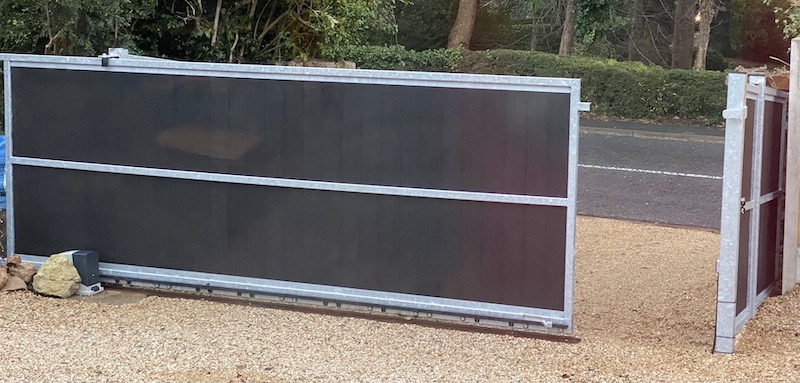
For gate motor, I went for a Nice Robus 600 which was a good balance of power and price. I set about installing it at the gate, which involved digging a hole at one side, filling it with concrete and fixing the gate base-plate on top of this, at the right level for the bottom of the gate. This was tricky enough as the motor needs to be carefully positioned so its metal cog wheel is level (to drive the gate) and is in the exact position for the rail. But after a lot of work and repositioning the motor level and angle using the holding bolts, the motor was in place and the gate would slide manually with the lock open. I would unlock the motor with the supplied key, open the lever and the gate could run back and forth.
Electrical Work:
Having installed the gate motor in the correct position, the next steps were the power and sensors. The gate needs its own power supply back to a fuse board and its own isolator switch (you can't just plug it in with an extension cord!). This was the trickiest part- I needed to run cable through outdoor ducting across the drive and then outdoor electrical cable needed to pass through our garage to outside the back door. In the end this cost about €150 for one hours work by a local digger driver and handyman.
The next part was the electrician. There was no way I would attempt this myself. This needed an electrician to link the cable through the wall at the door and into the house to the fuse board. He connected it into the board with its own trip switch, and the line out now has its own switch to power on/off the motor. This was important as during the programming stage, the gate needs to be powered on and off at various times.
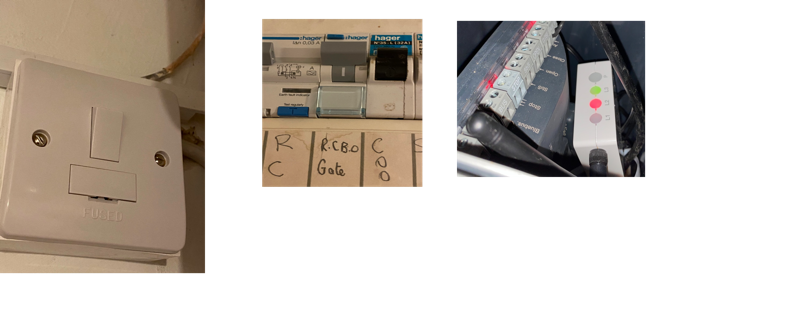
Isolator switch near back door : trip switch on fuse board : WiFi module (IT4WIFI) in gate box
Sensors, Programming and Accessories:
The electrician connected the cable to the Nice motor and once I knew I had (safe) power connected, the rest was over to me. I needed to install the two photocell sensors, which create a beam between each side of the gate. If broken, this signal would stop the gate from closing (for example is a person or car passed through as it was closing). Two photocells came with the motor kit and so I set them up on either side of the posts and linked them back to the “Bluebus” port on the Nice motor.
The final stage before activation was the programming. Nice UK have a number of helpful videos on YouTube which were invaluable. With the gate running smoothly on its rail in manual mode, and with the photocells linked, it was time to turn on the power and go through these steps. The gate has metal stoppers at either end, so the gate can be programmed to know where it runs to. Holding down a few of the buttons on the panel, the gate performs its initial search sequence, running back and forth to learn its end points. Now the gate was ready, and I could open and close it using the open/close buttons on the panel.
Remotes:
I also went the old fashioned way- I bought some remote controls for the gate. These are set up in two parts- first by plugging their radio module into the motor panel so that the gate has a receiver for the remotes. Then each remote is paired with that module. At tis stage I could now open ad close the gate, and be assured that anything breaking the photocells' beam would stop the gate in its tracks.
WiFi:
The next step was to add the gate motor to the house WiFi to add it to HomeKit. Luckily my office WiFi network extends far enough to give good coverage at the gate. I bought Nice's IT4WIFI aerial which plugs into the panel on the motor and lives inside its waterproof plastic covering. This was a simple step as it uses a telephone cable (RJ11), running from the small aerial box to the panel. After this I used the Nice Welcome HK app to add the gate to my network and I had a WiFi controllable gate.
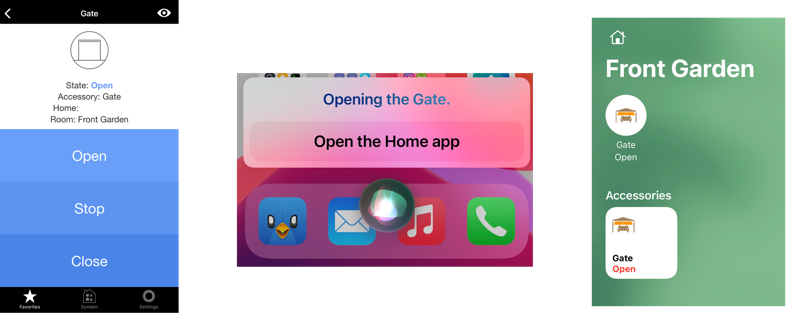
Nice Welcome HK app : Using Siri on iPhone to open the gate : Home app with the gate status
HomeKit:
I could have skipped the Nice Welcome app and gone straight for HomeKit, but I decided to have both. The final stage was to add the gate to the Home app on my iPhone, to assign it to a "room" and name it. This final step integrated the gate into the rest of my home accessories, including lights, dehumidifiers, power sockets and heating.
Now I can activate the gate using my iPhone or Apple Watch by saying: "Hey Siri, open the gate" or "Hey Siri, close the gate". I can ask "Hey Siri, is the gate open?" to check if it is shut at night. One of the best parts is the remote access, and the ability to open the gate as I approach my home in the car. As my Ford has CarPya, and a Siri button on the stalk, I can press the button and say “open the gate”.
Using my Apple Watch is also great- by holding in the Digital Crown, I can ask Siri to “close the gate” and off it goes. So simple and effective- no messing around with zappers or even apps.
The only slightly fussy device is the HomePod in our kitchen which insists on me “authenticating” on my iPhone before it will complete a gate request, possibly as a away to ensure the person speaking is allowed to control the gate. I can see this as a useful safety feature.
I will need to check the photocells frequently and the gate may need to be serviced every few years, but overall this project was very rewarding and I succeeded in integrating the gate motor to the rest of my HomeKit system.
The Future of iBooks
As a children's book author, I have been considering Apple's future options for iBooks and whether they would venture into the world of Windows or Android. After all, iTunes runs on Windows PC and Apple Music will be available on Android this Autumn, so why not iBooks on other non-Apple platforms?

But when I look closer at Apple's use of iBooks, I don't see this happening. Books is an interesting side-show for Apple and it fits nicely into content-consumption on the iPad and iPhone but it's not a core business. The iBooks Store arrived with the iPad, as Apple touted the virtues of books on the iPad for consumers and in education. But it is not central to Apple's business and so does not receive the attention that say the iTunes and Apple Music stores receive.
Anyone who has interacted with the iBooks team will also know that the number of people behind iBooks is relatively small. The changes in the iBooks Store over the years have been gradual but not revolutionary.
Instead, Apple see the iBooks app as an important piece inside iOS and OS X. The benefits of the iBooks app come as part of the operating system and the user experience on an iPad, iPhone or (recently) Mac, and launching a parallel experience for Windows and Android is not something Apple will do. iBooks is key to iOS/OS X, which in turn is part of the user experience on an Apple device. The message is- if you want to experience the iBooks app, buy an iPad, iPhone or Mac!
Adding iBooks to the Mac was a nice extra but it is a different experience to using it on an iPad and iPhone. iBooks is most at home on iOS and especially on the iPad, then possibly on an iPhone 6 Plus, with other platforms such as the Mac coming at the end. Putting it onto Windows or Android is a further step away from Apple's central aim here.
In the end, while I would like to see iBooks extended out beyond iOS and OS X, I can't see it happening. With my author hat on, it would be great to reach new audiences. But as a long-time Apple observer, it goes against Apple's aims for iBooks, which is to draw more people to buy the iPad and other hardware devices.
[Note- at time of publication, the iBooks Author page still has not been updated to show that iBooks Author books can be read on an iPhone: https://www.apple.com/ibooks-author/]
WWDC 2015- What to Expect
Apple's developer conference, WWDC, is coming up next week with the keynote address on June 8th. Everyone should note that this event is geared towards developers and so some of the announcements are not focussed on consumers. Instead this event normally sets out the Apple agenda for the coming year, especially in terms of software.
One of the main parts of this will be the announcements on iOS 9 and OS X 10.11. Apple have committed themselves to a yearly upgrade schedule, and assuming this does not change, we will be introduced to a preview of the next versions. Expect to see information on items like CarPlay and HomeKit too, both aimed at the developer community. Showing off the new operating systems is key to working with the developer community.

However we are also likely to see the launch of two other item- the first is the revised iTunes and Beats Music service. Ever since Apple purchased Beats in 2014 it has been expected that we would see a revised service from Apple, including a music streaming service. It may be that we see this announced at WWDC but this could also come later in the year, which was traditionally the event when iPods, iPads or iPhones are launched. I expect to see an announcement at WWDC if Apple can get agreements in place with the record labels.
Apple TV will also be updated- the announcement earlier this year that the price of the current Apple TVs had dropped to a new low seemed to be a very strong hint of new hardware to come. A new Apple TV would also sit nicely next to a Beats music announcement, with a deal with other TV network operators likely. Apple announced a deal with HBO in March.
Don't expect much change in terms of Macs; the laptops have been updated recently. I expect the iMacs to be revised later this year and so one possibility is news on revised Mac Pros, something which might be appreciated by some developers.
Another intriguing piece of info would be the Watch OS- will Apple show off changes to Watch OS and announce new features? I expect to see Apple announce changes to attract high quality Watch apps and because this is the year of the Watch and Apple will be promoting these new features in the Christmas buying season.
Overall is is likely to be a tech-heavy keynote, setting out the software and a few hardware bits for the rest of 2015.
Third Party Apps for the Apple Watch
There are lots of third-party apps for the Apple Watch but many of them are simply an extension of the iPhone and have not thought out the Apple Watch design and screen.
Of the apps that I've tried so far, the best are the BBC News and Due. Due is a reminders app which is neatly displayed on screen and fills a gap given that the iOS Reminders app is not available on the Watch. It does what it should without giving too much clutter and provides simple notifications when a reminder is due. It is clean and unobtrusive and a useful example of a Watch app. BBC News also provides a few pieces of information with the current headlines and a short summary.
On the other side there are lots of quite useless apps, merely extensions of the iPhone version. Most of the Twitter apps don't make sense on the Watch- they seem to be there as a way to claim they have a Watch app, but with little functionality.
Thoughts So Far on the Apple Watch
After my first 24 hours with the Watch, here is a list of likes and concerns so far:
Likes-
- I bought a sports watch with the black rubber strap and it is very light and comfortable to wear. I gave up wearing a watch about 8 years ago and have been surprised at how unintrusive the Apple Watch feels on my wrist
- it looks good- a little thicker than my dream Apple Watch (!) but very neat and sleek
- I have been pleasantly surprised on how fast I have learnt the OS. I was expecting it to be more complex, probably due to the reviews I had read. But having watched the Apple videos in advanced, I have used the Watch without having to search for answers online. This may not be everyone's experience; I think it depends on expectations
- the packaging is a work of art, and the UK/IRL charger plug is brilliantly thought out
- my favourite parts of the OS are: the customisable clock faces, messages and answering calls!
- after 24 hours the battery stands at 40%. This is better than I expected. My iPhone battery is also higher at the end of the day as I spent less time using it- a lot less!
- the heart rate sensor is very interesting but I'm not sure I trust it just yet. A few readings were out of the general pattern for say an hour, and for no apparent reason. I am either doomed or the sensor can produce the odd glitch and we need to focus in the average. But overall I think it is a great health addition
- I like the activity features and how the Watch bugs me to be healthier. The prompt to stand up and move around may not be everyone's thing, but I like it
- best third party app so far- 1Password. A useful app where you can store a few crucial bits of info
- the best non-core Apple app has to be Remote- controlling my Apple TV from my wrist is very cool
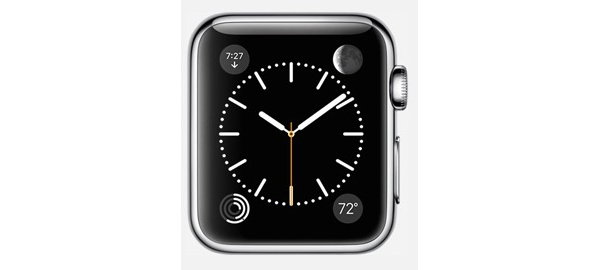
Concerns-
- I thought that the charger would have a stronger magnetic attraction to the back of the Watch. It's not a major problem but I did find myself reattaching it a few times to be sure it was charging
- I'm not 100% convinced by the need for the Friends button- it might be somewhat handy, but a dedicated button for this? On the issue of buttons, I seem to be using the digital crown far less than iwas intended. Both buttons for me are a last resort
- not being able to reply to an email is disappointing. There may be very good reasons why it's not available as an option, but it seems like a gap in the features. I know this will disappoint some users
- I wish I could remove or hide some of the built-in apps to make the remaining apps on the app screen slightly larger. Right now those icons hover between usable and fiddly
- Siri has been almost good. But, for example, if there is a mistake in your message, you have to cancel and start the message again. It is not as effective as Siri on the iPhone
It will take a few days for me to have a fuller view on the Watch and how I will incorporate it into by daily routine, but so far it has been very useful. Plus it has kept me away from my iPhone and has saved time by allowing prompt responses to messages and quick reading of emails.
